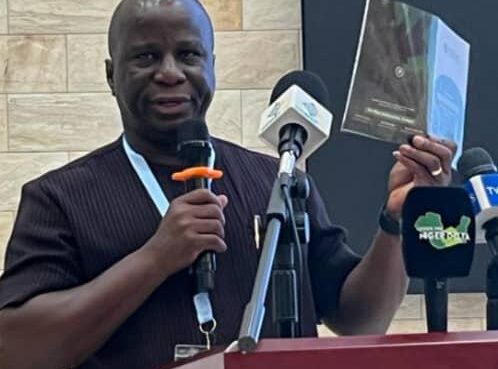A recent report carried out by the National Commission for Museums and Monuments, has it that in 1961, the Federal Government of Nigeria declared the Benin City Walls and Moats as a National Monument to be controlled by the Federal Department of Antiquities. It was this body which later transformed into the National Commission for Museums and Monuments by virtue of Decree 77 of 1979. By that law, the Federal government of Nigeria became the owner and protector of the Benin moats.
By Bob MajiriOghene Etemiku
The Benin Moats should be the Grand Canyon of Nigeria. They should be earning reasonable income for the Binis today and commanding the respect of the world.
Perhaps it is with this in view that the Guinness Book of Records mentioned them in 1978. They are believed to have been constructed during the reigns of two prominent Benin Kings – Oguola and Ewuare, who reigned in the 16th Century.
The Benin Moats surround the old Benin Empire now in Edo State, Nigeria. They cover an estimated area of 6,500 square kilometers, longer than the Great Wall of China. The Moats represent the largest single archeological phenomenon on earth. When they were built, they served two purposes: as a default drainage system and security chain of ramparts.
Cited in the Federal Government of Nigeria Gazette of 1976, the Benin Moats represent a major part of the historical evolution of the Binis of Nigeria, and a pride of a people respected as one of the seats of black history in Africa.
The Benin Moats are facing extinction. That fact itself is obvious. I remember when I was a boy growing up in Benin City. If you had the heart to be able to climb atop those massive dunes, you would be rewarded with a bird’s eye view of your immediate environment.
Every once in a while, we had the rare privilege of sighting antelopes, monkeys and an assortment of birds and wild life that you could only see these days on National Geographic media.
Even though our apartment was built a little too close to the moats, we used to enjoy climbing atop them to watch street football matches.
But today, illegal buildings and roads are being constructed right through the moats. Over a 30-year period, the massive clay dunes are being illegally excavated and have become a massive refuse dump.
I am a living witness – one morning as I prepared to go to school, we saw these trucks roll up in our backyard. Scores of laborers moved in with spades and dug the lovely red earth dunes up.
And by the time we returned from school, huge voids like scars appeared on the moats. In less than one month, our beautiful ‘stadium’ was gone.
We became exposed somewhat, not from dangerous animals but we were vulnerable in a certain kind of way without the natural protection that once used to come from living near the moats.
The gist around then was that our landlord, in buying the piece of land near the moats bought up the moats as well.
But that is not true. A recent report carried out by the National Commission for Museums and Monuments, has it that in 1961, the Federal Government of Nigeria declared the Benin City Walls and Moats as a National Monument to be controlled by the Federal Department of Antiquities.
It was this body which later transformed into the National Commission for Museums and Monuments by virtue of Decree 77 of 1979.
By that law, the Federal government of Nigeria became the owner and protector of the Benin moats. As a matter of fact, that decree stipulated that any person found encroaching or building a house or any structure less than 50ft to the crest of the walls or 100ft to the moats committed an offence and is liable for prosecution and imprisonment. (Akponana).
As we speak, Nigeria has more than 100 cultural heritage sites yet only two of them – the Sukur Cultural Landscape in Adamawa State and the Osun-Osogbo Sacred Groove are cited in the current UNESCO World Heritage webpage.
Information at the UNESCO World Heritage site has it that in 1998, both the Madagali Local Government, the Sukur Development Association, the State Council for Arts and Culture, and Adamawa State Government came together with the National Commission for Museums and Monuments for one purpose – to preserve the Sukur Cultural Landscape.
It was that collaboration that led to the inauguration of a management Committee in 2010 for a site management Plan to preserve and protect the Sukur Cultural Landscape.
In the whole of Africa, the people have no strong connection to their monuments as people in Europe and Asia and the Americas.
There are over 40 of these cultural and historical monuments in China, 51 in Italy, 41 in France, 40 in Germany, 33 in Mexico and 32 in India.
The Great Wall of China No 26 has more than 10,000 international visitors annually. And even though it has equivalent density and historical value with the Benin Moats, nobody visits the moats.
In spite of the rich cultural and historical embroidery that surrounds and covers the African Continent, only South Africa and Tunisia have up to eight cultural and historical monuments recognized by UNESCO. Zimbabwe has 5, Egypt 7, Senegal 7 and Nigeria, just 2.
Why is it like this? I spoke with the Heritage Officer of the Benin Museums, Bar. Emuakpor Akponana. “Our cultural sites have no outstanding Universal Value, OUV. For a cultural site to have OUV, the people must first of all be willing to surrender them to the authorities to manage and superintend,” he said to me.
Barrister Akponana cites several instances where he has had to arrest very prominent Benin sons and daughters who were excavating the moats for more land.
But as soon as they were arrested, they would simply get bail from the police and continue with their illegal excavation activities. He has tried to prosecute some as well but those guilty as charged come off with a slap on the wrist fine of a thousand naira.
After they pay their fine, they jolly well go on with the excavation of the moats. In September, 2011, the man saddled with the responsibility of demolishing illegal structures in Edo State, Major Lawrence Loye was put in cuffs before he was dismissed.
His offence appeared to be that he demolished buildings and structures of political Benin City bigwigs who had built their houses right on excavated land from the Benin moats.
After that summary dismissal, nothing has been heard of, of the effort of the Edo State government to salvage the dwindling fortunes of the moats.
But we must not continue this way. I believe that the reason why the Benin people are excavating the moats is that they do not know what these moats tell them about their heritage, ancestry and history, and the prestige and respect they stand to gain if they preserve the moats.
To stem this ignorance, I believe that a massive enlightenment campaign first should be what we must do to educate and enlighten our people.
I also believe as well that we must tweak and modernize the laws guiding our historical monuments to make excavating from the moats a serious offence for which incarceration would be a consequence.
The Russians have this saying that if we remember and protest our heritage and history, we will lose only an eye and lose both eyes if we do not remember our past.
What is going on in Benin City today concerning those moats is equivalent to cutting our noses to spite our faces.
Bob MajiriOghene Etemiku is communications manager, Africa Network for Environment and Economic Justice, ANEEJ, Benin City. @DsighRobert.






Osarumwense Okunmwendia liked this on Facebook.